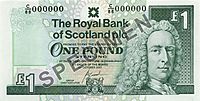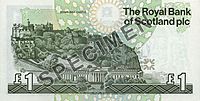The Royal Bank of Scotland £1 note facts for kids
| (United Kingdom) | |
|---|---|
| Value | £1 sterling |
| Width | 128 mm |
| Height | 65 mm |
| Security features | Raised print, metallic thread, watermark, microlettering, see-through registration device, UV feature |
| Paper type | Cotton |
| Years of printing | 1727–present 1987–present (current design) |
| Obverse | |
 |
|
| Design | Lord Ilay |
| Design date | 1987 |
| Reverse | |
 |
|
| Design | Edinburgh Castle |
| Design date | 1987 |
The Royal Bank of Scotland £1 note is a special kind of money, called a banknote, used in Scotland. The notes we see today are made of cotton and first came out in 1987. On the front, they show Lord Ilay, who helped start the bank. On the back, you'll find a picture of Edinburgh Castle.
This £1 note is the smallest paper money made by The Royal Bank of Scotland. The bank stopped making new £1 notes regularly in 2001. Even though they are still valid money, you don't often see them used for shopping since about 2006.
The Story of the £1 Note
Why Scottish Banks Print Money
Did you know that some banks in Scotland, like The Royal Bank of Scotland, can print their own banknotes? This has been happening for a very long time! The Royal Bank of Scotland first started printing its own money in 1727, the same year the bank was created.
Scottish banknotes are accepted as money all over the United Kingdom. This means if you have a Scottish £1 note, you can use it in England, Wales, or Northern Ireland, just like you would use a Bank of England note.
Early £1 Notes: A Look Back to 1727
When The Royal Bank of Scotland first opened in 1727, it began printing notes worth twenty shillings. This was the same as £1. These early notes were printed in black ink on only one side.
Each twenty-shilling note was signed by hand by a bank cashier. They also added a unique number to each one. The cashier even wrote down the value in old Scots pounds. This was a currency that had stopped being used 20 years earlier, after Scotland and England joined to form Great Britain. The bank kept doing this until 1792 to help people trust and accept their new banknotes.
These first notes were also special because they were the first British banknotes to show a picture of a king. They featured a small image of King George II, who had just become king. Printing portraits was hard and costly back then. So, having the King's picture made it much harder for people to make fake notes.
How They Stopped Fake Money in the Old Days
In the past, banknotes were kept in bundles at the bank, much like a modern cheque book. When a note was given out, the cashier would cut it from the bundle with a wavy line. Later, if someone brought the note back to the bank for payment, a clerk would check if it was real. They did this by matching the wavy cut edge of the note to the piece it was cut from. They also checked that the numbers on the note and the matching piece were the same. This helped stop fake notes.
New Designs and Better Printing
By 1826, printing methods had improved a lot, thanks to new steel plates. The Royal Bank's £1 note from this year looked much more detailed. It was also the first British banknote to be printed on both sides! This note showed a picture of King George IV. After this, The Royal Bank of Scotland stopped putting pictures of kings or queens on their regular banknotes.
In 1832, a new design for the £1 note was created. This design stayed almost the same for 136 years! It showed the bank's name with the Royal Arms of Scotland above it. On either side were the famous Scottish symbols, The Lion and the Unicorn. In the middle was a picture of King George I. This was to remember that he gave permission for the bank to start in 1727. The note also had pictures of Britannia, who represents Britain, and Plenty, who holds a cornucopia (a symbol of lots of good things).
Changes in the 20th Century
In 1968, the £1 note got its first big makeover. For the first time, there was no king or queen on the note. Instead, it showed a picture of David Dale, an important businessman who worked at the bank's first office in Glasgow. This was also the first time The Royal Bank of Scotland made a banknote with full colour. It also had the bank's coat of arms and a metal security strip to make it safer.
Soon after, in 1969, The Royal Bank of Scotland joined with another bank. They then made a new series of notes that combined designs from both banks. These new notes were green, matching the colour used for £1 notes across the UK. The front had the bank's coat of arms, and the back showed the Forth Road Bridge.
The Ilay Series: Our Current £1 Note
In 1987, The Royal Bank of Scotland released the "Ilay series" of banknotes. These notes are named after Lord Ilay, who was the first governor of the bank. His picture is on the front of all the notes in this series. This picture is based on a painting of Lord Ilay from 1744.
Other parts of the design include the bank's coat of arms and logo. You can also see the front of Dundas House, which is the bank's main building in Edinburgh. There's even a pattern that looks like the ceiling inside the bank's main hall. Lord Ilay's picture also appears as a watermark when you hold the note up to the light.
All the notes in the Ilay series have a castle on the back. On the back of the £1 note, you can see Edinburgh Castle and the National Gallery of Scotland.
As mentioned, £1 notes are not used much anymore. The Royal Bank was the last bank in Scotland to print £1 notes, and they stopped making them in 2001. In 2015, the bank started making new notes out of a special plastic material called polymer, replacing the £5 and £10 notes from the Ilay series.
Different £1 Note Designs Over Time
| Note | First issued | Colour | Size | Design | Additional information |
|---|---|---|---|---|---|
| George II | 1727 | Black | King George II | Value of twenty shillings | |
| George IV | 1826 | Black | King George IV | ||
| George I | 1832 | Black | King George I | ||
| Dale | 1968 | Green | Front: David Dale; Back: Dundas House | ||
| Interim | 1968 | Green | Front:Royal Bank coat of arms; Back: Forth Road Bridge | ||
| Ilay | 1987 | Green | 128 × 65 mm | Front: Lord Ilay; Back: Edinburgh Castle |
Special Commemorative £1 Notes
The Royal Bank of Scotland has also made special £1 notes to celebrate important events. In 1992, they made the first special commemorative banknote in Britain and Europe! This note was made to mark a big meeting called the European Council Summit, which took place in Edinburgh.
Since then, the Royal Bank has made more special banknotes, including £1 notes, to celebrate major national events or anniversaries.
| Date of issue | Commemoration | Colour | Design | Additional information |
|---|---|---|---|---|
| 1992 | European Summit | Green | Palace of Holyroodhouse and the European flag | Europe's first commemorative banknote |
| 1994 | Centenary of the death of Robert Louis Stevenson | Green | Portrait of Stevenson; a montage of characters and scenes from his books; Stevenson's homes in Edinburgh and on Samoa | |
| 1997 | 150th anniversary of the birth of Alexander Graham Bell | Purple | Montage of telephones, geese, sheep and the phonetic alphabet invented by his father | The first banknote in the EU to feature a hologram |
| 1999 | Inauguration of the Scottish Parliament | Purple | General Assembly Hall of the Church of Scotland (temporary home of the Parliament); plan of Enric Miralles's new Scottish Parliament Building (as yet unbuilt) |
Images for kids





